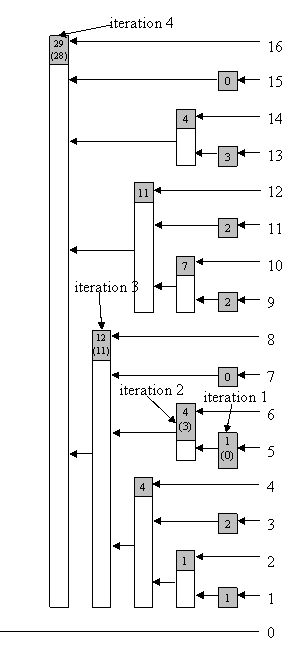Binary Indexed Trees[二进制索引树]
来源:互联网 发布:装修效果图软件免费 编辑:程序博客网 时间:2024/06/06 09:58
英文原文链接:链接地址
蓝色是笔者注释,高手请忽略
简介
为了使我们的算法更快,我们总是需要一些数据结构。在这篇文章中我们将讨论二进制索引树(Binary Indexed Tree)。依据Peter M. Fenwick,这个数据结构首先用于数据压缩。现在它多用于存储频率和操作累计频率表。
问题定义如下:我们有N个盒子。通常的操作是
1. 在第i个盒子中加入球
2. 求从盒子l到盒子k中球的总和
最天真的做法对于操作1而言时间复杂度是O(1),对于操作2的时间复杂度是O(n)。假设我们查询m次,最坏情况下操作的时间复杂度是O(m*n)。使用一些数据结构(例如RMQ我也不知道是什么东西)可以将这个问题的最差时间复杂度控制在O(m*lg n)。另一种解决方式就是使用Binary Indexed Tree数据结构,最坏情况下的时间复杂度依然是O(m*lg n),然是Binary Indexed Tree更容易编码,也有更小的空间使用量,相比RMQ而言。
注记
BITBinary Indexed Tree 二进制索引树MaxVal maximum value which will have non-zero frequency 非零最大值f[i]frequency of value with index i, i = 1 .. MaxVal 这个可以理解为每个盒子中小球的个数c[i]cumulative frequency for index i (f[1] + f[2] + ... + f[i])tree[i]sum of frequencies stored in BIT with index i (latter will be described what index means); sometimes we will write tree frequency instead sum of frequencies stored in BIT
在BIT中存储的频率(小球个数)的和;有时在BIT中我们使用tree 频率来替代频率和num¯complement of integer num (integer where each binary digit is inverted: 0 -> 1; 1 -> 0 ) 求num的反 NOTE: Often we put f[0] = 0, c[0] = 0, tree[0] = 0, so sometimes I will just ignore index 0.
在BIT中存储的频率(小球个数)的和;有时在BIT中我们使用tree 频率来替代频率和num¯complement of integer num (integer where each binary digit is inverted: 0 -> 1; 1 -> 0 ) 求num的反 NOTE: Often we put f[0] = 0, c[0] = 0, tree[0] = 0, so sometimes I will just ignore index 0.
基本思路
每个整数都可以表示为2的次幂的和。同理,累计的频率也可以表示为子频率集合的和。在我们这篇文章里,每一个集合含有一些连续但互补重合的频率子集。
idx是BIT的索引,r是idx以二进制表示后最右侧的0的位置( 很绕口,解释一下哈。比如idx为12,二进制为1100,则r=2。再来一个,idx=9,二进制1001, 则r=0)。那么tree[idx]是从 ( idx - 2^ r + 1)到idx的平率和(看表1.1)(即f[idx - 2^r + 1]+...f[idx])。同时我们还说idx是负责(responsible)从(idx - 2^r + 1)到idx的索引( 注意,这里是算法的关键,也是操作tree的方法)。
1 2 3 4 5 6 7 8 9 10 11 12 13 14 15 16 f 1021130425223102c 1134588121419212326272729tree 1124140122721134029
table 1.1
(Tips:不要尝试去推理f(i)的值,因为这是给定的例子。c[i]和tree[i]是计算的结果,需要理解)
table1.2 responsibility 表 (即tree[i]表示是f[]~f[]的和,例如tree[10]=f[9]+f[10])
image 1.3 tree 负责的index(bar显示的是累加的频率)

image 1.4 带有tree频率和的tree
假设我们要寻找index 13的累加频率。在二进制表示中,13表示为1101。据此我们计算c[1101]=tree[1101]+tree[1100]+tree[1000]。
找出最后的1
我们需要多次的从二进制数中获得最后一个1,所以我们需要一个高效的方法。假设我们想从num中获取最后的1.在二进制中num可以表示为a1b,a代表最后一个1之前的所有二进制位,b表示在这个1之后的0.
-num = (a1b)¯+ 1 = a¯0b¯ + 1. 由于b全市由0构成,所以b¯全部是1.由此可得
-num = (a1b)¯ + 1 = a¯0b¯ + 1 = a¯0(0...0)¯ + 1 = a¯0(1...1) + 1 = a¯1(0...0) = a¯1b.
我们现在可以简单的获得最后一个1,让num和-num做位与运算:
a1b
& a¯1b
--------------------
= (0...0)1(0...0)
& a¯1b
--------------------
= (0...0)1(0...0)
读取累计的频率和
如果我们需要读取整数idx的频率累计和,我们可以让sum加上tree[idx]的值,然后让idx减去最有一个1(我们也可以说移走最后的1,使最后的1变为0),然后重复上述过程直至idx为0.我们可以使用下面这段代码(C++)。
1int read(int idx){2 int sum = 0;3 while (idx > 0){4 sum += tree[idx];5 idx -= (idx & -idx);6 }7 return sum;8}
image 1.5 箭头指示了在遍历过程中使用的数据.
所以我们的结果是26.这个函数中遍历的次数是idx含有的1的个数,最大的便利次数也就是log MaxVal。
时间复杂度: O(log MaxVal).
代码的复杂度: 如上代码
改变一些位置的频率并更新tree
当改变某些位置的频率时,所有tree中负责该位置的都需要更新。在读取idx的累计和时我们移走idx最后的1并且循环继续。修改tree中的一些值val时,我们需要增加当前idx的tree值tree[idx],增加idx最后一位的1(例如idx为6,该值增加了val,当tree[6]增加了val后。6的最后等于1的一位是2,所以6+2=8,需要继续修改tree[8]的值)并且循环继续之前的过程,只要idx小于MaxVal.C++写的函数如下
1void update(int idx ,int val){2 while (idx <= MaxVal){3 tree[idx] += val;4 idx += (idx & -idx);5 }6}例如idx=5:

image 1.6 更新idx为5的频率时遍历的顺序
使用如上算法我们可以更新整个BIT。
时间复杂度: O(log MaxVal)
代码长度:最长10行
读取某个位置的频率值
(未翻译)
整个树乘以或除以某个常数
(未翻译)
给定累计的频率值,找出index(翻译这么多终于到我要用的地方了)
最笨最天真的解决方法就是遍历整个索引,计算累计频率,检查是否等于给定的值。如果考虑存在负数的话,这是唯一解决方案。但是如果我们只有非负的频率值的话(也就是说对于递增的index,累计频率值不减少)我们可以找到指数级的算法,这个算法由二分搜索修改而来。逐步遍历所有的位(从最高为开始),比较当前index的累计频率和给出的值,依据大于小于结果选择高一半或者低一半(就像二分查找)。C++写的函数如下:
01// if in tree exists more than one index with a same02// cumulative frequency, this procedure will return03// some of them (we do not know which one)04 05// bitMask - initialy, it is the greatest bit of MaxVal06// bitMask store interval which should be searched07int find(int cumFre){08 int idx = 0; // this var is result of function09 10 while ((bitMask != 0) && (idx < MaxVal)){ // nobody likes overflow :)11 int tIdx = idx + bitMask; // we make midpoint of interval12 if (cumFre == tree[tIdx]) // if it is equal, we just return idx13 return tIdx;14 else if (cumFre > tree[tIdx]){15 // if tree frequency "can fit" into cumFre,16 // then include it17 idx = tIdx; // update index18 cumFre -= tree[tIdx]; // set frequency for next loop19 }20 bitMask >>= 1; // half current interval21 }22 if (cumFre != 0) // maybe given cumulative frequency doesn't exist23 return -1;24 else25 return idx;26}27 28 29 30// if in tree exists more than one index with a same31// cumulative frequency, this procedure will return32// the greatest one33int findG(int cumFre){34 int idx = 0;35 36 while ((bitMask != 0) && (idx < MaxVal)){37 int tIdx = idx + bitMask;38 if (cumFre >= tree[tIdx]){39 // if current cumulative frequency is equal to cumFre,40 // we are still looking for higher index (if exists)41 idx = tIdx;42 cumFre -= tree[tIdx];43 }44 bitMask >>= 1;45 }46 if (cumFre != 0)47 return -1;48 else49 return idx;50}当cumFre为21 时调用find的情况:
时间复杂度: O(log MaxVal)
代码长度: 小于20行
0 0
- Binary Indexed Trees[二进制索引树]
- Binary Indexed Trees[二进制索引树]
- 树状数组(Binary Indexed Trees,二分索引树)
- Binary Indexed Tree(二进制索引树、树状数组)
- Binary Indexed Trees
- Binary Indexed Trees
- 树状数组(Binary Indexed Trees)
- 树状数组(Binary Indexed Trees)
- 树状数组 Binary Indexed Trees
- Algorithm Tutorials Binary Indexed Trees (树状数组)
- 【数据结构】: 树状数组 (Binary Indexed Trees)
- binary indexed tree 二分索引树 树状数组
- 树状数组 ( Binary Indexed Tree,BIT,二分索引树 )
- 树状数组 ( Binary Indexed Tree,BIT,二分索引树 )
- 【索引】Binary Trees
- 【索引】Binary Trees
- 【索引】Binary Trees
- 【索引】Binary Trees
- Android Studio 上 更改SVN地址
- SATA2.0和SATA3.0硬盘速度对比
- 最值得阅读学习的 10 个 C 语言开源项目代码
- MQTT协议详解一
- mysql在控制台中文显示乱码的解决办法
- Binary Indexed Trees[二进制索引树]
- yii2登录笔记
- ConcurrentHashMap原理分析
- Oracle使用like时要注意空条件的情况,请尽量使用以下语句(对含逗号或特定符号的查询)
- 77. Combinations
- 一般硬盘读取速度和写入速度是多少
- SQL注入教程详解
- 修改系统的编码方式
- maven 设置 打包的 编码


